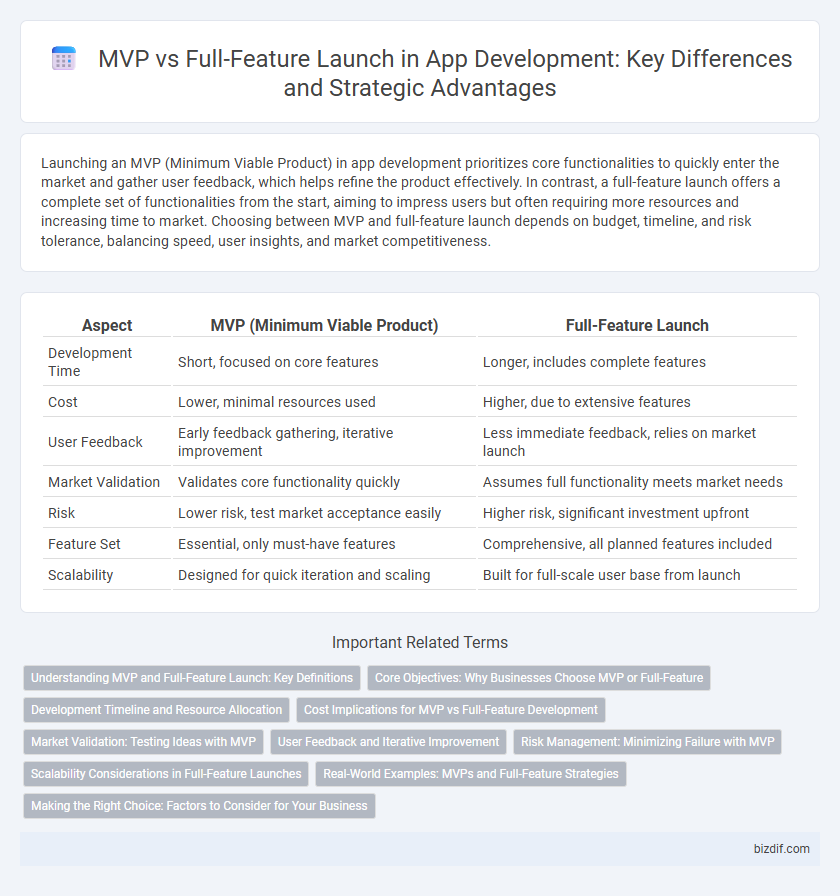Launching an MVP (Minimum Viable Product) in app development prioritizes core functionalities to quickly enter the market and gather user feedback, which helps refine the product effectively. In contrast, a full-feature launch offers a complete set of functionalities from the start, aiming to impress users but often requiring more resources and increasing time to market. Choosing between MVP and full-feature launch depends on budget, timeline, and risk tolerance, balancing speed, user insights, and market competitiveness.
Table of Comparison
| Aspect | MVP (Minimum Viable Product) | Full-Feature Launch |
|---|---|---|
| Development Time | Short, focused on core features | Longer, includes complete features |
| Cost | Lower, minimal resources used | Higher, due to extensive features |
| User Feedback | Early feedback gathering, iterative improvement | Less immediate feedback, relies on market launch |
| Market Validation | Validates core functionality quickly | Assumes full functionality meets market needs |
| Risk | Lower risk, test market acceptance easily | Higher risk, significant investment upfront |
| Feature Set | Essential, only must-have features | Comprehensive, all planned features included |
| Scalability | Designed for quick iteration and scaling | Built for full-scale user base from launch |
Understanding MVP and Full-Feature Launch: Key Definitions
An MVP (Minimum Viable Product) is the initial version of an app containing only core features essential to address the primary user problem and validate market demand. A full-feature launch delivers a comprehensive product with extensive functionalities designed to provide a complete user experience and competitive differentiation. Understanding MVP and full-feature launch definitions helps optimize development timelines, minimize initial costs, and strategically plan iterative enhancements based on user feedback.
Core Objectives: Why Businesses Choose MVP or Full-Feature
Businesses choose MVP development to rapidly validate core objectives, minimize costs, and gather user feedback for iterative improvements. Full-feature launches prioritize delivering comprehensive functionality to capture market share and provide immediate value to end-users. Aligning development strategy with business goals ensures either a lean startup approach or a robust product introduction.
Development Timeline and Resource Allocation
An MVP (Minimum Viable Product) launch significantly shortens the development timeline by focusing on core functionalities, enabling faster market entry and early user feedback. Resource allocation for an MVP prioritizes essential features, reducing costs and allowing iterative improvements based on real user data. In contrast, a full-feature launch demands extensive development time and larger investment to build comprehensive functionality, potentially delaying market presence and increasing initial risk.
Cost Implications for MVP vs Full-Feature Development
Developing an MVP (Minimum Viable Product) significantly reduces initial costs by focusing on core functionalities and avoiding complex features that require extensive resources. Full-feature development demands higher investment in time, talent, and technology, often leading to increased expenses for design, testing, and post-launch support. Investing in an MVP allows startups to validate ideas with minimal financial risk before scaling to a full-featured application.
Market Validation: Testing Ideas with MVP
Launching a Minimum Viable Product (MVP) allows app developers to test core features and gather real user feedback quickly, reducing time and costs compared to a full-feature launch. MVPs enable validation of market demand and user preferences, helping identify necessary improvements before investing in additional functionalities. This iterative approach minimizes risk by aligning development closely with actual user needs and ensures a stronger product-market fit.
User Feedback and Iterative Improvement
Launching an MVP (Minimum Viable Product) prioritizes collecting user feedback to identify critical features and usability issues early, enabling prioritized iterative improvements. This approach reduces development costs and accelerates time-to-market compared to a full-feature launch, which risks building complex features without validated user needs. Emphasizing continuous user-driven iterations ensures the app evolves to meet actual demands, enhancing user satisfaction and long-term retention.
Risk Management: Minimizing Failure with MVP
Launching an MVP (Minimum Viable Product) significantly reduces development risks by allowing early user feedback and iterative improvements, minimizing costly full-scale failures. By focusing on core functionalities, teams can validate market demand and identify potential issues before committing extensive resources. This approach ensures a more controlled risk environment compared to full-feature launches, which often face higher failure rates due to untested, complex features.
Scalability Considerations in Full-Feature Launches
Full-feature launches require robust infrastructure to support increased user load and complex functionalities, emphasizing scalability through cloud services and microservices architecture. Building with scalability in mind ensures seamless performance as user demand grows, preventing system bottlenecks and downtime. Investing in scalable databases, load balancers, and continuous integration pipelines is critical for sustaining long-term app growth.
Real-World Examples: MVPs and Full-Feature Strategies
Real-world examples highlight how companies like Airbnb and Dropbox leveraged MVPs to rapidly validate ideas with minimal features while securing early user feedback and investment. In contrast, platforms such as Facebook initially launched with a more comprehensive feature set to capture a broad user base and establish network effects quickly. This strategic difference underscores the importance of aligning product development with market goals and resource availability for successful app launches.
Making the Right Choice: Factors to Consider for Your Business
Choosing between an MVP and a full-feature launch hinges on factors such as budget constraints, time to market, and target user feedback. An MVP allows rapid validation of core functionalities and user needs while minimizing initial investment risk. A full-feature launch requires extensive development resources but can establish stronger market presence and competitive advantage from the outset.
MVP vs Full-Feature Launch Infographic

 bizdif.com
bizdif.com